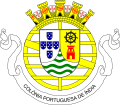| Emblem of Goa | |
|---|---|
 | |
| Armiger | The Government of Goa |
| Crest | National Emblem of India |
| Shield | Vriksha Deep |
| Supporters | Open hands |
| Motto | सर्वे भद्राणि पश्यन्तु मा कश्चिद् दुःखमाप्नुयात् May everyone see goodness, may none suffer any pain |
The Emblem of Goa is the official emblem of the Government of Goa, a state of India. [1] [2]







